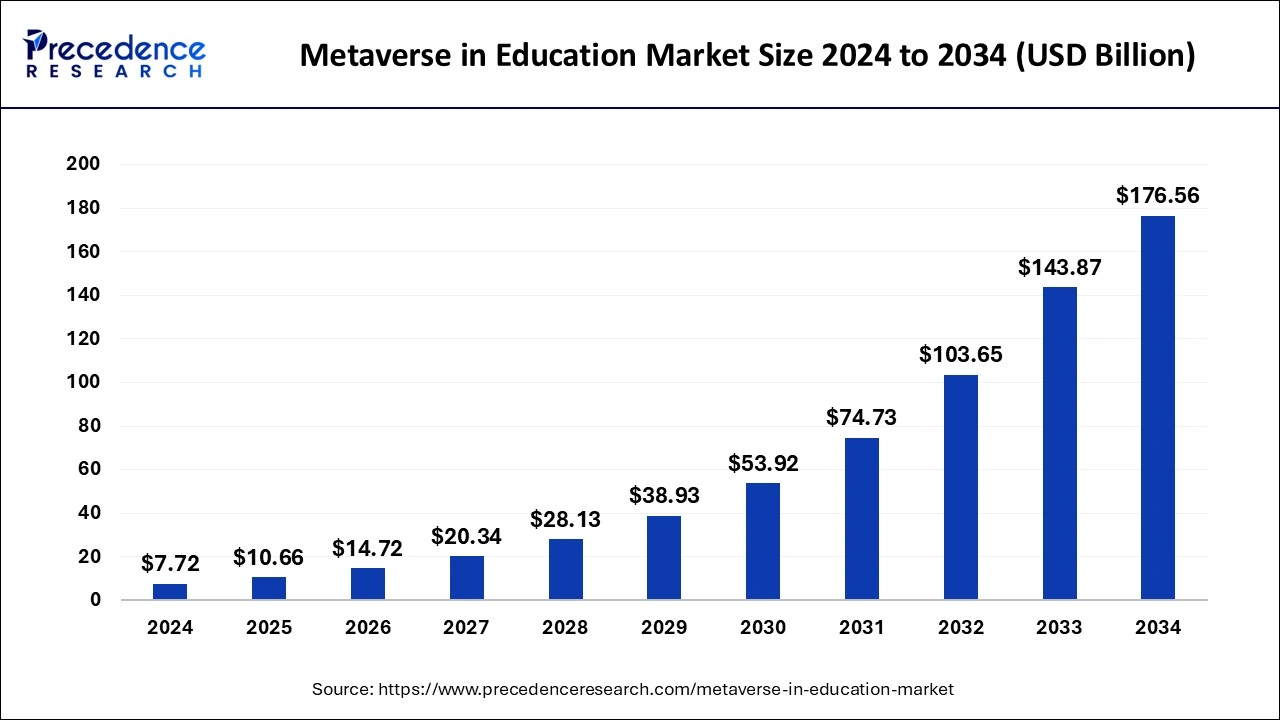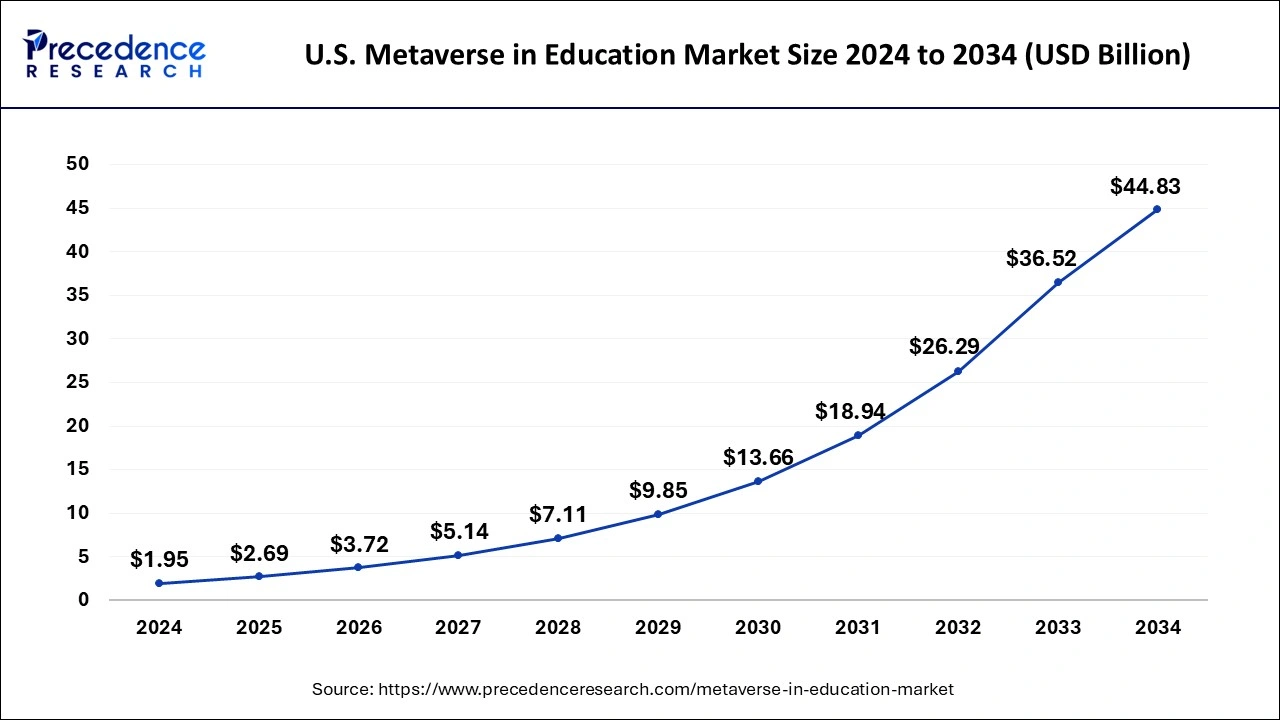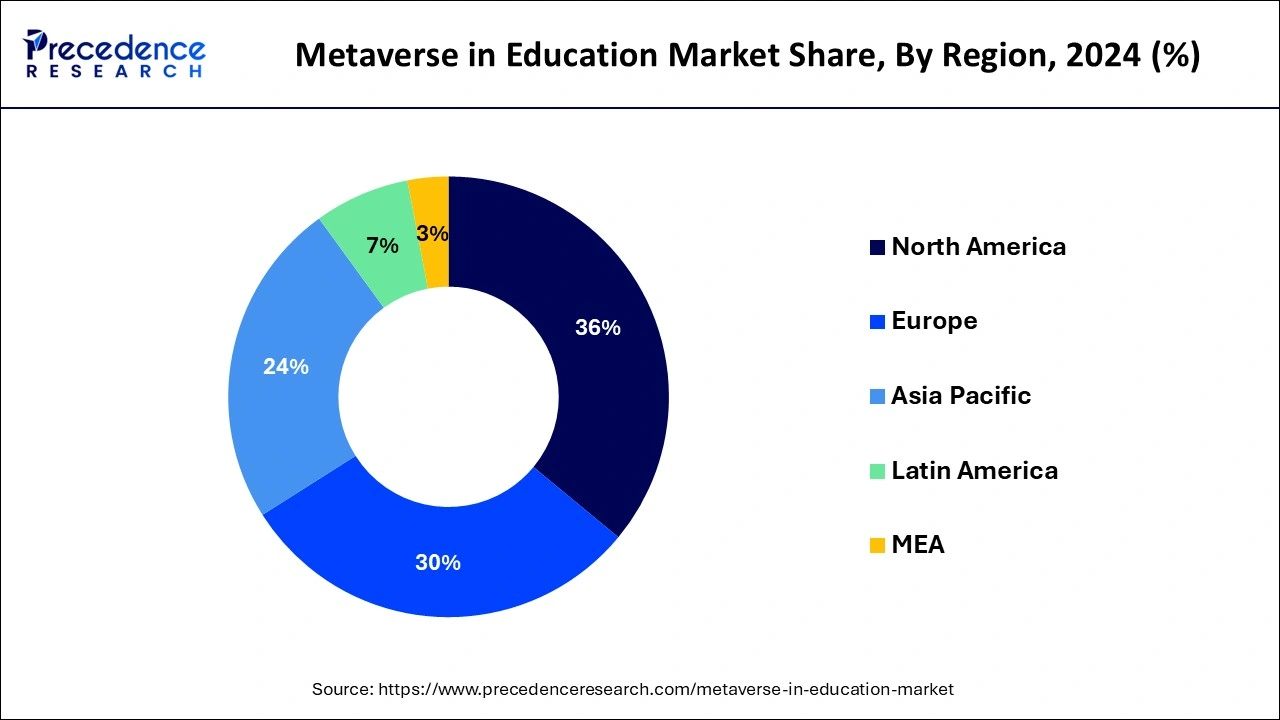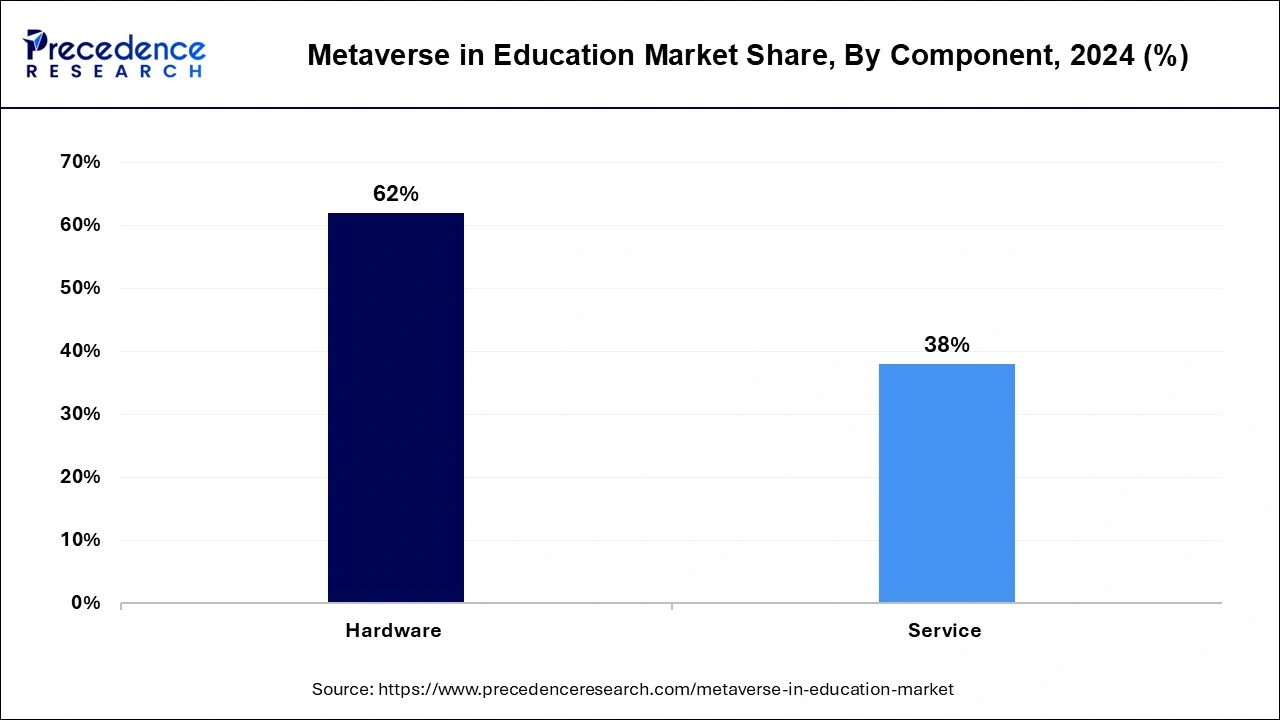List of Contents
Metaverse in Education Market Size and Forecast 2025 to 2034
The global metaverse in education market size was calculated at USD 7.72 billion in 2024 and is predicted to increase from USD 10.66 billion in 2025 to approximately USD 176.56 billion by 2034, expanding at a CAGR of 36.75% from 2025 to 2034.

Metaverse in Education MarketKey Takeaways
- The global metaverse in education market was valued at USD 7.72 billion in 2024.
- It is projected to reach USD 176.56 billion by 2034.
- The metaverse in education market is expected to grow at a CAGR of 36.75% from 2025 to 2034.
- North America contributed more than 36% market share in 2024.
- The Asia-Pacific region is estimated to expand the fastest CAGR between 2025 and 2034.
- By component, the hardware segment has held the largest market share of 62% in 2024.
- By component, the service segment is anticipated to grow at a remarkable CAGR of 39.14% between 2025 and 2034.
- By application, the educational apps segment generated over 26% market share in 2024.
- By application, the learning segment is expected to expand at the fastest CAGR over the projected period.
U.S. Metaverse in Education Market Size and Growth 2025 to 2034
The U.S. metaverse in education market size was evaluated at USD 1.95 billion in 2024 and is projected to be worth around USD 44.83 billion by 2034, growing at a CAGR of 36.82% from 2025 to 2034.

In 2024, North America held a share of 36% in the metaverse in the education market due to its robust technological infrastructure, substantial investments in educational technology, and a mature digital ecosystem. The region boasts advanced virtual reality (VR) and augmented reality (AR) capabilities, coupled with a strong emphasis on innovation in education. Leading tech companies and educational institutions in the United States and Canada actively drive the integration of the metaverse, contributing to North America's major share by fostering cutting-edge developments and widespread adoption of immersive learning technologies in the education sector.

The metaverse in education is poised for rapid expansion in the Asia-Pacific region due to increasing technological advancements, rising investments in educational technology, and a growing demand for innovative learning solutions. Governments and institutions in countries like China, India, and Japan are actively embracing the metaverse to enhance educational experiences, bridge learning gaps, and prepare students for the digital future. This surge in interest, coupled with a tech-savvy population, positions the Asia-Pacific market as a key driver for the metaverse's substantial growth in the education sector.
Meanwhile, Europe is experiencing notable growth in the metaverse in the education market due to a confluence of factors. The region is witnessing increased investments in educational technology, a proactive approach from governments in integrating innovative solutions, and a rising demand for virtual and immersive learning experiences. European countries are leveraging the metaverse to address diverse educational needs, promote digital literacy, and enhance collaboration in learning. This momentum, driven by a combination of technological adoption and educational priorities, positions Europe as a significant player in the expanding global metaverse in the education market.
Market Overview
The metaverse in education refers to a virtual, interconnected space where students and educators can engage in immersive and interactive learning experiences using digital technologies. In this evolving educational landscape, traditional classrooms extend into a dynamic online environment, offering opportunities for collaborative projects, virtual field trips, and simulations that enhance learning. Students can access diverse resources, connect with peers globally, and participate in virtual classrooms, fostering a more inclusive and engaging educational experience. The metaverse in education holds the potential to revolutionize traditional teaching methods, making learning more accessible, interactive, and tailored to individual needs, paving the way for a transformative shift in the future of education.
Metaverse in Education Market Data and Statistics
- The COVID-19 pandemic accelerated the adoption of online education, with a reported 93% increase in virtual learning platform usage globally.
- In 2021, global EdTech funding reached $16.1 billion, indicating a substantial investor interest in innovative education technologies.
- According to UNESCO, over 1.3 billion students worldwide lacked access to remote learning during the pandemic.
- Growth Factors
- Continuous improvements in virtual reality (VR), augmented reality (AR), and other immersive technologies drive the metaverse in education. As hardware becomes more affordable and software more sophisticated, institutions are increasingly adopting these tools to create engaging and realistic virtual learning environments.
- The metaverse breaks down geographical barriers, allowing students from different parts of the world to connect and collaborate seamlessly. This accessibility promotes cultural exchange, diverse perspectives, and the sharing of educational resources on a global scale.
- The metaverse facilitates personalized learning experiences, catering to individual student needs and preferences. Adaptive learning algorithms and interactive simulations within the metaverse enable educators to tailor content, pacing, and assessments, enhancing the effectiveness of education for diverse learning styles.
- The accelerated adoption of remote and hybrid learning models, particularly in response to the COVID-19 pandemic, has driven the demand for metaverse solutions. Institutions seek versatile platforms that offer immersive, interactive, and collaborative experiences to keep students engaged in virtual or blended classrooms.
- Incorporating gamification elements within the metaverse enhances student engagement and motivation. Educational games and interactive simulations make learning enjoyable while fostering critical thinking and problem-solving skills. The gamified approach aligns with modern pedagogical strategies that prioritize active and experiential learning.
- Increasing investments from both the private and public sectors, along with collaborations between educational institutions and tech companies, propel the growth of the metaverse in education. As stakeholders recognize its potential, funding for metaverse-related projects, research, and development continues to expand, driving innovation and market expansion.
Market Scope
| Report Coverage | Details |
| Growth Rate from 2025 to 2034 | CAGR of 36.75% |
| Market Size in 2025 | USD 10.66 Billion |
| Market Size by 2034 | USD 176.56 Billion |
| Base Year | 2024 |
| Forecast Period | 2025 to 2034 |
| Segments Covered | Component and Application |
| Regions Covered | North America, Europe, Asia-Pacific, Latin America, and Middle East & Africa |
Market Dynamics
Driver
Collaboration and Social Interaction
The metaverse emphasizes collaborative and social interactions, providing a platform for students worldwide to connect and learn together.
- This aligns with the growing importance of social learning; 82% of educators believe that social interaction enhances the learning experience.
Collaboration and social interaction play a pivotal role in boosting the demand for the metaverse in education. The metaverse fosters an environment where students can connect and learn together, breaking down geographical barriers and promoting a sense of global community. This interconnectedness not only enhances cultural exchange but also enables collaborative projects and discussions, enriching the overall learning experience. Moreover, the metaverse addresses the need for meaningful social interactions in virtual learning spaces.
As students engage with immersive content and simulations, they can communicate, share ideas, and collaborate on projects, mimicking the interactive dynamics of a physical classroom. This emphasis on social learning meets the growing demand for education that goes beyond traditional boundaries, creating a more inclusive and dynamic educational landscape. As a result, the market for the metaverse in education surges, driven by the desire to provide students with interactive and socially engaging learning environments.
Restraint
Technological barriers
Technological barriers serve as a significant restraint for the metaverse in education market. Many schools and institutions face challenges in acquiring the necessary technology infrastructure to support immersive learning experiences. The cost of high-quality augmented reality and virtual reality devices, coupled with the need for robust internet connectivity, can strain budgets, limiting the widespread adoption of the metaverse in education. This impediment particularly affects less affluent educational settings, creating a digital divide where some students have access to these advanced technologies while others do not. Moreover, the complexity of implementing and maintaining these technologies presents a hurdle. Educational institutions may lack the expertise required to integrate and manage VR/AR systems effectively. As a result, technological barriers act as a deterrent, hindering the seamless incorporation of the metaverse into mainstream education and limiting its potential impact on enhancing learning experiences.
Opportunity
Rising investments in EdTech
The escalating investments in Educational Technology (EdTech) create promising opportunities for the metaverse in education.
- In 2021, global EdTech funding reached a record-breaking $16.1 billion.
This influx of capital fuels the development of metaverse solutions, enabling the integration of immersive and interactive technologies into mainstream education. These investments facilitate the creation of cutting-edge platforms and tools that enhance the quality of virtual learning experiences. As stakeholders recognize the transformative potential of the metaverse in education, collaborations between EdTech companies, educational institutions, and investors are burgeoning. This collaborative effort not only drives innovation but also opens avenues for the widespread adoption of metaverse technologies, offering students and educators new and dynamic ways to engage with educational content, and fostering a more interactive and inclusive learning environment.
Component Insights
In 2024, the hardware segment held the highest market share of 62% based on the component. In the metaverse in education market, the hardware segment encompasses the physical devices essential for immersive experiences, such as virtual reality (VR) headsets, augmented reality (AR) glasses, and haptic feedback devices. Trends indicate a shift towards more affordable and user-friendly hardware solutions, enhancing accessibility for educational institutions. Additionally, advancements in hardware technology focus on improving the overall quality of virtual experiences, ensuring that students and educators can seamlessly integrate these devices into their learning environments for a more immersive and engaging educational journey.

The service segment is anticipated to witness rapid growth at a significant CAGR of 39.14% during the projected period. In the metaverse in education market, the service segment refers to the suite of support and maintenance offerings accompanying metaverse solutions. These services include implementation support, training, content creation, and ongoing technical assistance. As the metaverse gains traction, service providers are witnessing a rising demand for tailored training programs to familiarize educators with virtual environments. Additionally, the surge in content creation services reflects the need for engaging and curriculum-aligned virtual experiences, showcasing a trend towards comprehensive service offerings to maximize the educational potential of the metaverse.
Application Insights
According to the application, the educational apps segment has held a 26% market share in 2024. The educational apps segment in the metaverse education market encompasses applications designed to enhance learning experiences through virtual and augmented reality. These apps provide interactive simulations, virtual classrooms, and collaborative tools, offering students immersive educational content. A notable trend involves the integration of gamified elements within educational apps, making learning more engaging. As technology advances, educational apps in the metaverse are evolving to offer personalized, adaptive learning experiences, catering to diverse learning styles and fostering a dynamic and inclusive educational environment.
The learning segment is anticipated to witness rapid growth over the projected period. In the metaverse in education market, the learning segment refers to the diverse applications of immersive technologies in educational settings. This includes virtual classrooms, interactive simulations, and gamified learning experiences. A significant trend involves the rise of personalized and adaptive learning within the metaverse, tailoring educational content to individual student needs. As technology advances, this segment is witnessing a shift towards more dynamic and engaging learning environments, fostering creativity, collaboration, and a deeper understanding of academic concepts through interactive and immersive experiences.
Recent Developments
- In March 2023, Microsoft introduced Microsoft Mesh, a groundbreaking mixed-reality platform. This innovative platform enables users to collaborate and interact in a shared virtual space. Microsoft Mesh offers various tools to create and customize virtual avatars, objects, and environments. Integration with products like HoloLens and AltspaceVR facilitates seamless cross-platform collaboration.
- In January 2022, HP Inc. unveiled HP Fortis laptops, specifically designed for classroom demands. The Fortis lineup caters to active learners, offering durability to withstand drops and resist spills. Featuring textured surfaces, these lightweight devices are ergonomically designed, making them easier for students of all ages to grip and handle.
- In March 2022, GOFA International released Luca & Friends, an innovative app utilizing AI-backed motion capture technology. This educational app encourages physical activity through fun games, addressing concerns about sedentary lifestyles in today's tech-driven world for families, schools, and after-school programs.
- In April 2021, Unity Reflect launched as a real-time 3D rendering and visualization platform. This platform empowers designers and architects to create immersive 3D models for virtual walkthroughs, design reviews, and applications in architecture, engineering, education, and construction.
Metaverse in Education Market Companies
- Microsoft
- Facebook (Meta)
- Unity Technologies
- NVIDIA Corporation
- HTC Corporation
- Sony Corporation
- Oculus VR (acquired by Meta)
- Samsung Electronics
- Lenovo Group
- Alphabet Inc.
- Apple Inc.
- Magic Leap
- Qualcomm Technologies
- PTC Inc.
Segments Covered in the Report
By Component
- Hardware
- Services
By Application
- Learning, Skill Development
- Educational Apps
- Self-Regulation Skills
- Cultural Understanding
By Geography
- North America
- Europe
- Asia-Pacific
- Latin America
- Middle East and Africa
For inquiries regarding discounts, bulk purchases, or customization requests, please contact us at sales@precedenceresearch.com
Frequently Asked Questions
Ask For Sample
No cookie-cutter, only authentic analysis – take the 1st step to become a Precedence Research client